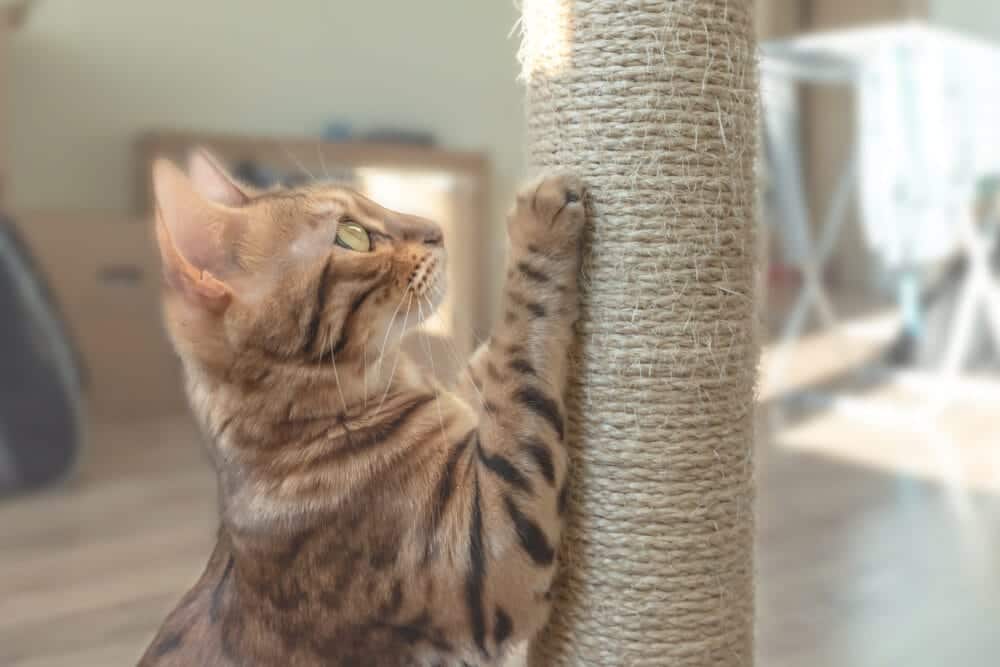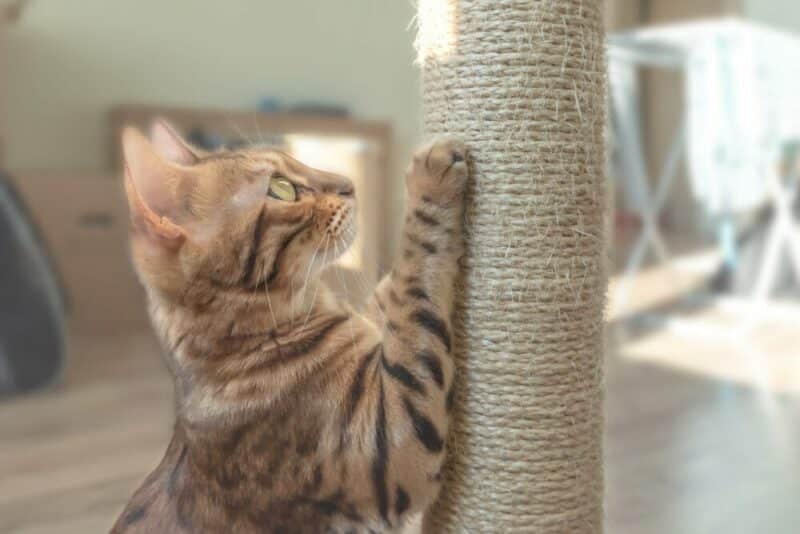A cat scratcher provides felines with a safe way to engage in their usual scratching behavior, which helps them maintain the health of their claws. It enables them to remove the outer sheaths of their claws, which need to be shed occasionally as their claws grow. Therefore, a cat scratcher isn’t really about sharpening or dulling a cat’s nails—it’s about removing the outer dead layers.
Cat scratchers do not sharpen a cat’s nails like you may sharpen a knife. Instead, the old, worn layer is removed to make way for the fresh layer underneath, which is often sharper. However, the nail can become overgrown and overly sharp without a cat scratcher, which can be a significant problem.
Felines will find a way to scratch even if you don’t provide them with the proper locations or materials. Scratching is a normal, instinctive cat behavior. However, a cat may not scratch enough for different reasons, the most common being painful joints due to arthritis. This can lead to their nails becoming too sharp or too long. In these cases, you may need to clip their nails for them. You can do this at home or have a vet or groomer do it.
How Do I Keep My Cat’s Claws Healthy?
Without proper care, your cat’s claws can become increasingly overgrown and sharp. Fortunately, there are several things that you can do to help your cat’s claws stay healthy.
1. Provide a Scratching Surface
You should give your cat access to a cat scratcher or similar surface for them to scratch. You may need several of these scratching surfaces if you have a big house or several cats.
Different cats also have different scratching preferences. Some prefer to scratch vertically, while others prefer to scratch horizontally. Therefore, meeting these preferences can be helpful.
Cats naturally like to scratch to mark objects with their scent, stretch their muscles, and keep their claws healthy. A scratching post provides a textured surface for them to scratch, which can help naturally file down the claws and prevent them from becoming too sharp.
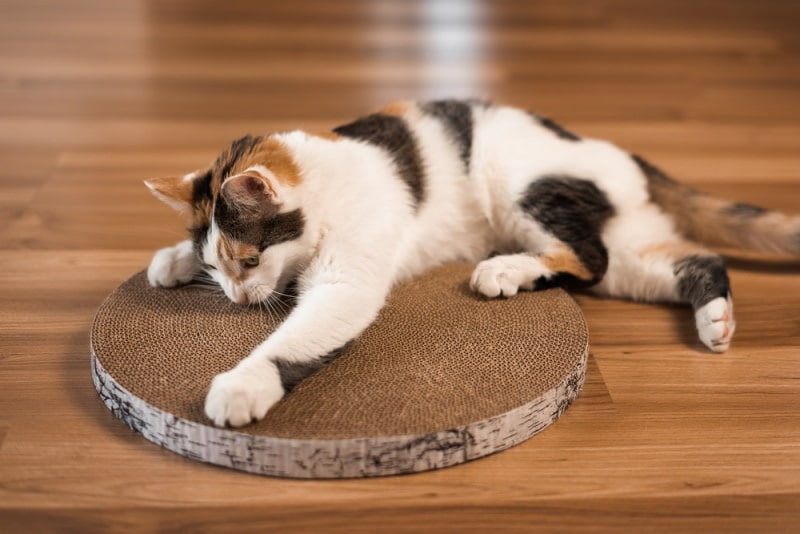
2. Choose the Right Material
While some cats may have individual preferences for scratching surfaces, others are less picky. Typically, sisal, carpet, and cardboard are the best options. Most commercial cat scratchers are made with one of these materials.
The “right” material varies from cat to cat. Therefore, you may need to experiment with different materials to determine which option is best for your cat.
3. Ensure the Proper Placement of the Scratcher
The placement of the scratcher also matters, though some cats will be pickier than others in this regard. You should put the scratcher where your cat spends the most time. If your cat scratches in a certain place naturally, you may want to place it there.
If you have several scratchers, place them in different locations. This helps your cat find somewhere to scratch no matter where they are.
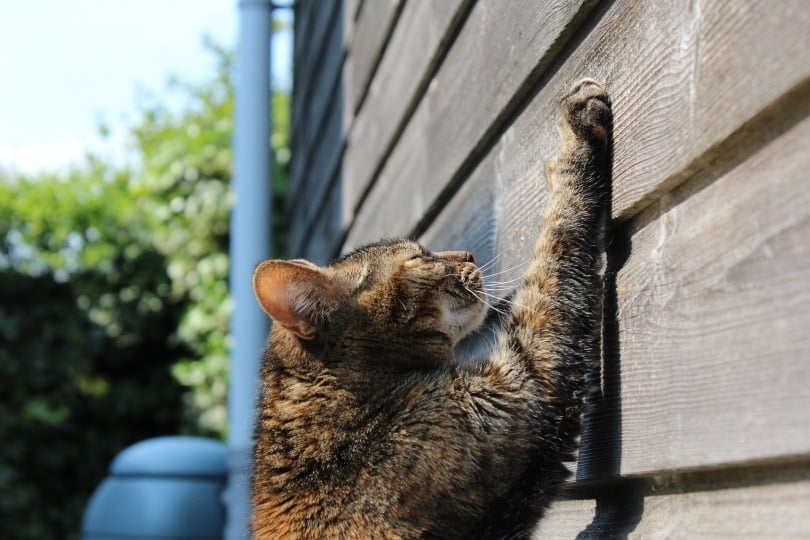
4. Encourage Proper Scratching
While you don’t want cats scratching furniture, you do want them to scratch on the proper surfaces. By scratching these, your cat takes care of their nails, which is precisely what you want them to do.
Therefore, it’s best to redirect and encourage your cat’s scratching in the proper places. If you only get onto them when they’re scratching in the wrong places, they might assume you don’t want them to scratch at all. Of course, this can be a problem and lead to overgrown nails.
5. Do Regular Nail Trimmings
Regular nail trimmings may be necessary for some cats. Different cats have different grooming needs. Sometimes, their nails grow faster than they can wear them down. Therefore, you must trim their nails as necessary.
You can do this at home or have a groomer do it. Many groomers allow for quick appointments that only involve nail trimmings.
- Complete Set - These cat nail clippers include both a large and small pair, meaning it works well as...
- Razor Sharp Stainless Steel - The most comfortable cat nail clippers for indoor cats provide a fast...
- Safety First - With a safety nail guard and locking spring, you can make sure every grooming cut is...
Trimming your cat's nails at home can be hard, but having a professional do it can be expensive. With the help of great tools like Hepper's Cat Nail Clipper Set, you can easily and quickly trim your cat's nails at home. This set includes two pairs of stainless steel clippers with safety guards and locking mechanisms, plus a built-in nail file and a convenient pouch.
At Catster, we’ve admired Hepper for many years and decided to take a controlling ownership interest so that we could benefit from the outstanding designs of this cool cat company!
Do Scratching Posts Make Cat Claws Sharper?
No, scratching posts do not make cat claws sharper or make them more pointed or dangerous. Scratching posts provide a textured surface that enables cats to engage in their natural scratching behavior.
When cats scratch on a suitable surface like a scratching post, they remove the outer sheaths of their claws, which may have become dull or frayed, and reveal the new layers underneath.
Regular scratching on appropriate surfaces, like scratching posts, helps prevent claws from becoming excessively sharp or overgrown. It also helps to keep the claws at an ideal length and condition.
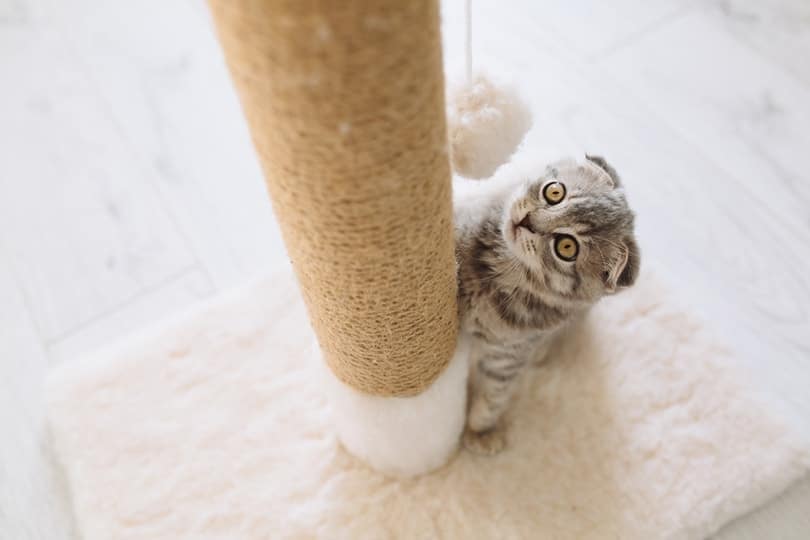
Do Cat Claws Get Dull?
Yes, cat claws can become dull over time. The outer sheath of a cat’s claw is made of keratin, the same material that makes up human nails. As cats use their claws for various activities like scratching, climbing, and playing, the outer layer of the claw can become worn down or frayed. Regular scratching on appropriate surfaces, such as scratching posts, helps cats shed the outer layers of their claws, revealing brand-new layers.
However, if a cat’s claws are not regularly maintained or if they do not have access to suitable scratching surfaces, the outer layer of the claws can accumulate and become dull. This can lead to discomfort for the cat, as excessively long or dull claws may cause issues like snagging, difficulty retracting the claws, or uncomfortable walking.
To prevent claws from becoming excessively dull or overgrown, it’s important to provide cats with appropriate scratching surfaces, encourage regular scratching behavior, and if needed, trim their claws using cat nail clippers. Regular nail maintenance helps ensure the claws are at an appropriate length and condition for the cat’s comfort.
Final Thoughts
Cat scratchers do not really make a cat’s nails sharper or duller. Instead, the nails are constantly refreshing themselves with new layers. The old layers will slowly wear out as the cat uses their nails. Eventually, these will be shed by scratching, revealing the newer layers underneath.
If cats never used their nails, they would get very sharp and very long, prompting a need for human intervention. Scratching will make the old layers fall off, making the nails their proper length and condition again. It’s an ongoing cycle—not one or the other.
Featured Image Credit: Svetlana Rey, Shutterstock

